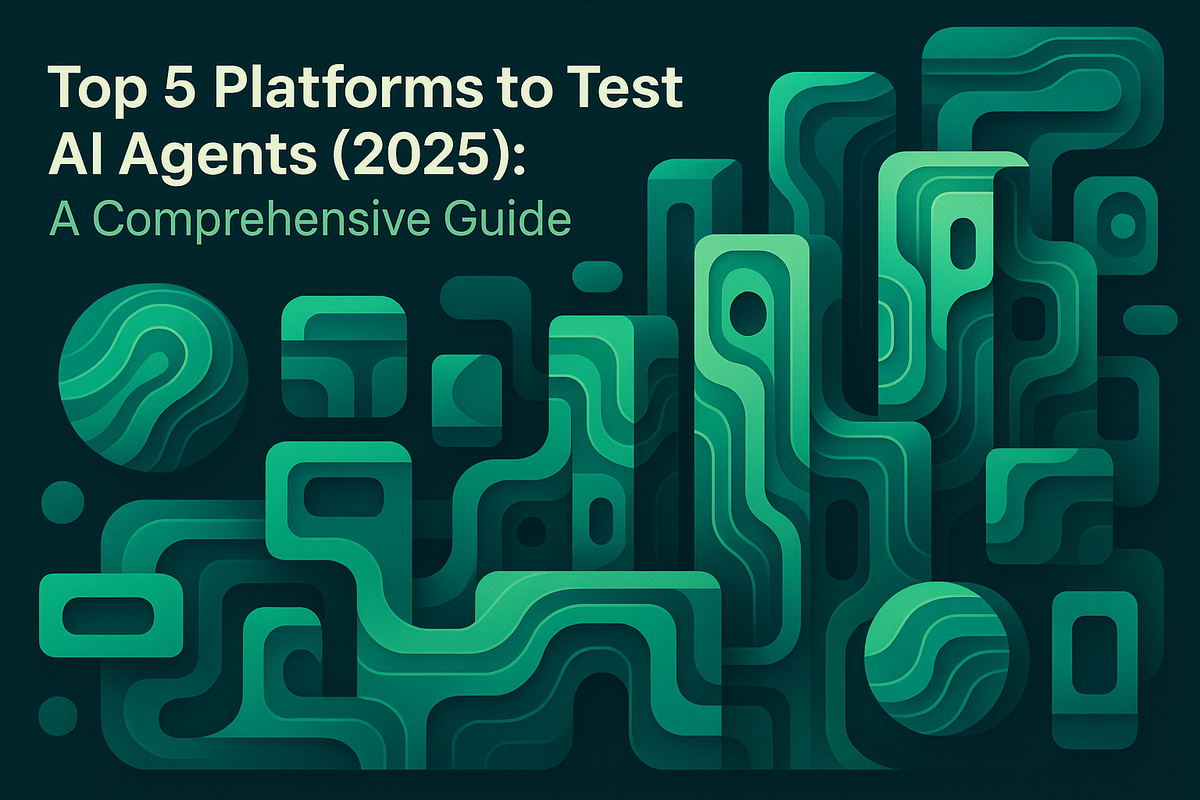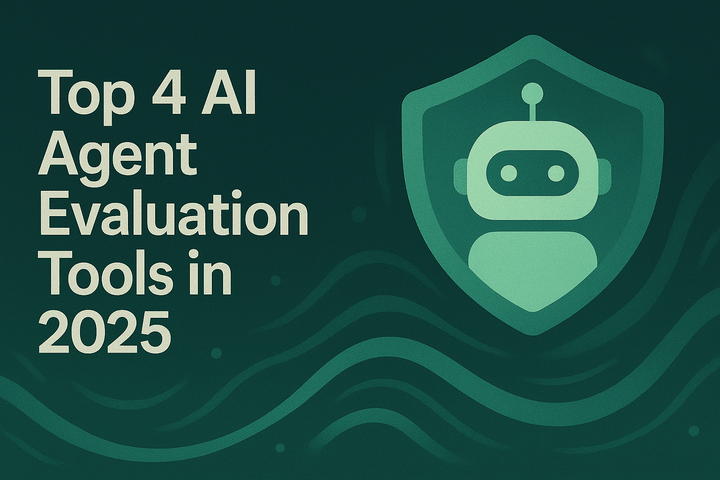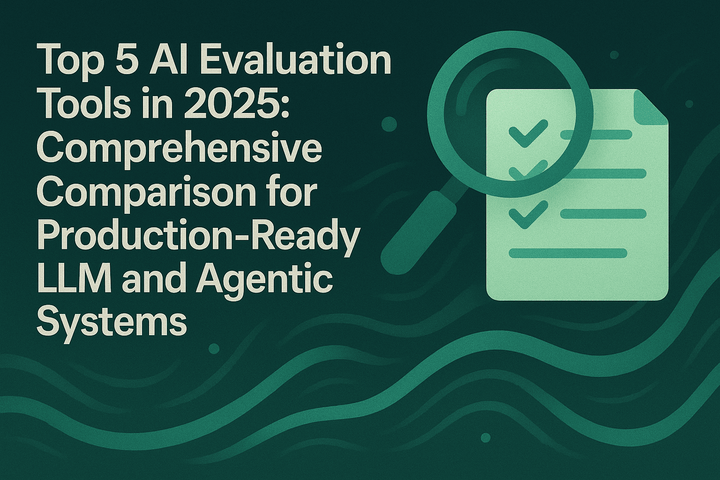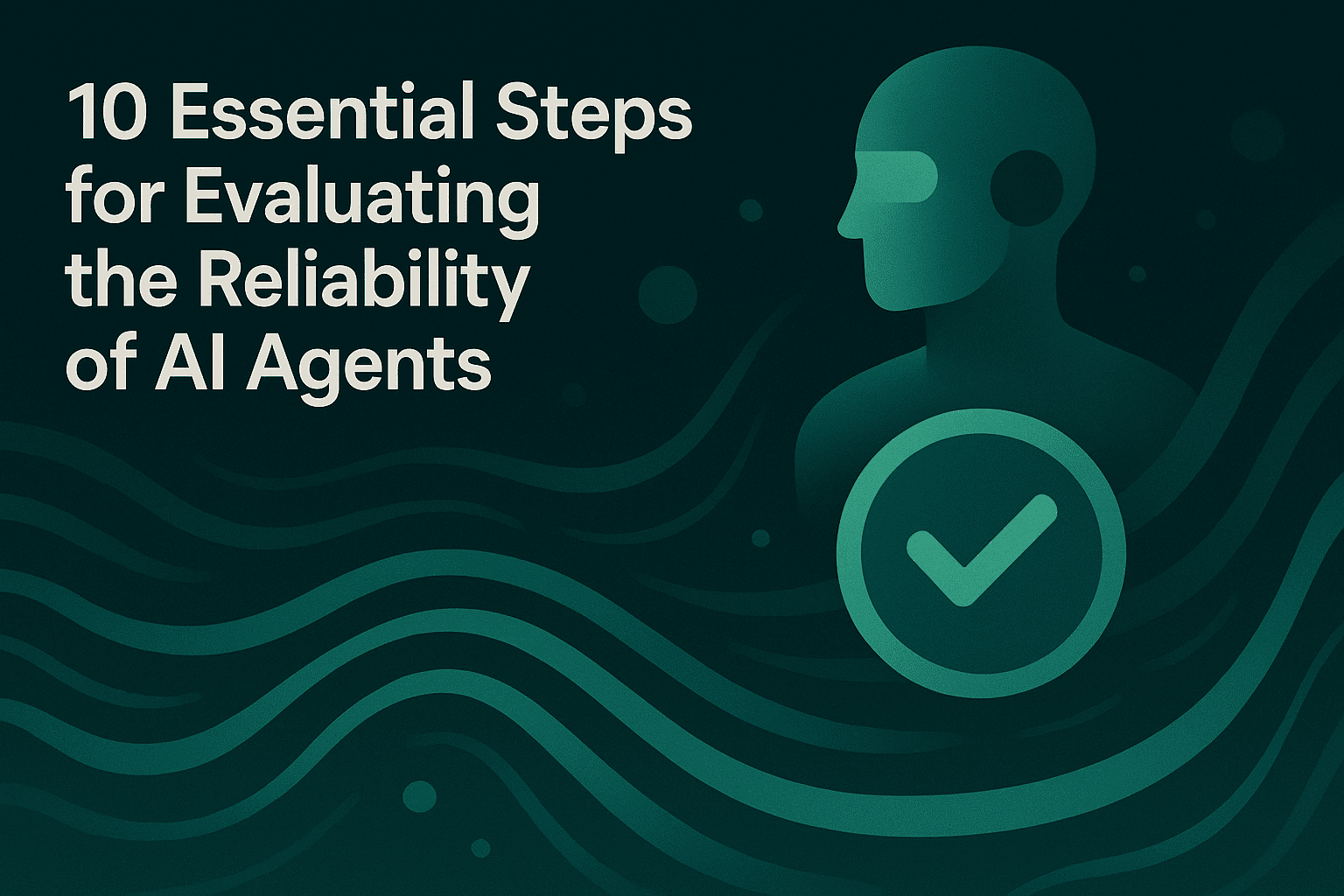Top 5 Platforms to Test AI Agents (2025): A Comprehensive Guide

Building reliable AI agents requires more than great prompts and powerful models. Teams need a disciplined approach to agent simulation, LLM evaluation, RAG evaluation, voice evaluation, and production-grade observability. This guide compares the top platforms practitioners use today, explains the capabilities that matter, and highlights where each tool is a strong fit. It is written for AI engineers and product teams who care about AI quality, agent debugging, and cross-functional velocity.
What “testing AI agents” actually entails
Testing AI agents spans pre-release and production workflows:
- Agent simulation and evals: Run controlled scenarios across user personas, tasks, and edge cases to evaluate trajectories, task completion, helpfulness, safety, and adherence to business rules. Evaluations often combine programmatic checks, statistical metrics, and LLM-as-a-judge techniques to approximate human assessments. See the survey: A Survey on LLM-as-a-Judge.
- RAG evaluation and tracing: Measure retrieval quality (e.g., relevance, precision@K, NDCG) and generation quality (e.g., faithfulness, factuality). Instrument RAG pipelines with distributed tracing to pinpoint failure modes at span-level granularity. See: Evaluation of Retrieval-Augmented Generation: A Survey.
- Voice agent evaluation: Assess STT accuracy, TTS naturalness, latency, interruption handling, barge-in, and conversation-level outcomes. Voice observability requires streaming traces, span events, and voice-specific metrics such as WER and MOS.
- AI observability and monitoring: In production, non-determinism and tool-calling complexity make traditional logs insufficient. Platforms must provide distributed AI tracing, payload logging, automated online evals, alerting, and human review loops to sustain AI reliability. Overview article: AI Observability Platforms: How to Monitor, Trace, and Improve LLM-Powered Applications.
Selection criteria for this guide
To keep this comparison practical for engineering and product teams, we emphasize:
- End-to-end coverage: Does the platform support experimentation, simulation, evaluation, and observability across agent lifecycles?
- Evaluator flexibility: Can teams combine deterministic, statistical, and LLM-as-a-judge evaluators and run them at session/trace/span level?
- Tracing depth: Does the platform offer distributed tracing across model calls, RAG components, tool invocations, and voice pipelines?
- Collaboration and governance: Are workflows friendly to product teams (low/no-code), with RBAC, SSO, cost controls, and auditability?
- Enterprise readiness: Self-hosting or In-VPC options, SOC2/ISO alignment, and robust SDKs/integrations.
The top 5 platforms to test AI agents
1) Maxim AI
Maxim AI is a full-stack platform for agent simulation, evaluation, and observability, designed to help teams ship AI agents reliably and more than 5x faster. It is particularly strong for multimodal agents and cross-functional collaboration between AI engineers and product teams.
- Experimentation and prompt engineering: Advanced prompt workflows in Playground++ with prompt versioning, side-by-side comparisons, and deployment variables. See Experimentation.
- Agent simulation and evaluation: Configure scenario-based simulations across personas and tasks; analyze agent trajectories; re-run from any step to reproduce issues and find root causes. Flexible evaluators include deterministic rules, statistical scores, and LLM-as-a-judge, with human-in-the-loop reviews for nuanced quality checks. See Agent Simulation & Evaluation.
- Observability and agent tracing: Production-grade observability with distributed tracing at session/trace/span level; payload logging with redaction; online evals and quality alerts; custom dashboards and saved views. See Agent Observability.
- Data engine: Curate multi-modal datasets from logs and eval outcomes; manage splits for targeted regressions and fine-tuning.
- AI gateway (Bifrost): A high-performance AI gateway unifying 12+ providers behind an OpenAI-compatible API with automatic failover, load balancing, semantic caching, governance, observability hooks, and budget controls. Explore Bifrost docs: Unified Interface, Provider Configuration, Automatic Fallbacks, Semantic Caching, Governance & Budget Management, Observability, SSO Integration.
Where it stands out:
- End-to-end lifecycle: unified experimentation → simulation → evaluation → observability workflows for agents, RAG systems, and voice agents.
- Evaluator flexibility and human reviews: session/trace/span-level llm evals, bespoke rules, and human adjudication to align with user preferences.
- Enterprise UX for collaboration: no-code configuration for product teams, plus high-performance SDKs in Python, TypeScript, Java, and Go.
Best for:
- Teams seeking a single platform to instrument, simulate, and evaluate agents pre-release and at scale in production with strong AI observability and monitoring.
2) Langfuse
Langfuse is known for open-source LLM observability and application tracing. It focuses on trace capture across inputs, outputs, retries, latencies, and costs, with support for multi-modal stacks and framework-agnostic SDKs. It is favored by teams building custom pipelines who want to self-host and control their instrumentation.
Best for:
- Engineering teams prioritizing open-source tracing and building their own bespoke observability stacks.
3) Arize
Arize offers AI engineering workflows for development, observability, and evaluation, expanding traditional ML observability into LLM contexts with drift detection, dashboards, and online evals. It’s strong for enterprises with established MLOps pipelines and requirements for model monitoring in production.
Best for:
- Enterprises with extensive ML infrastructure wanting ML observability features extended to LLMs and agent workflows.
4) Opik (Comet Opik)
Opik provides logging and evaluation for LLM traces during development and production. Teams use it to visualize agent executions, track costs and latency, and run evaluations. As an open-source friendly option, it can fit teams that value composability and control across their LLM tooling.
Best for:
- Teams that want an approachable way to log traces and run evals while retaining flexibility in their LLM stack.
5) Braintrust
Braintrust focuses on evaluation infrastructure for AI systems, including agent evaluation and testing workflows. Practitioners use it to operationalize evals across complex multi-step agents. It gives engineering teams deep control, though product-oriented workflows can be less central.
Best for:
- Engineering-led organizations that want granular evaluator control and structured eval pipelines for multi-agent systems.
How to choose: capability checklist
Use the following checklist to decide which platform fits your needs:
- Agent simulation depth: Can you simulate diverse real-world personas and task trajectories, re-run from any step, and capture tool calls, RAG spans, and voice stream events for agent debugging and agent tracing?
- Evaluator stack: Do you have off-the-shelf evaluators for faithfulness, answer relevance, hallucination detection, and safety, plus the ability to build custom evaluators and run llm evals and human reviews where needed? See background: A Survey on LLM-as-a-Judge.
- RAG observability: Can the platform instrument retrieval and generation, track relevance labels, measure ranking quality (e.g., NDCG, precision@K), and run RAG evaluation at both offline and online stages? See overview: Evaluation of Retrieval-Augmented Generation: A Survey.
- Voice observability: Are voice pipelines first-class, streaming traces, interruption handling, barge-in detection, WER/MOS metrics, and multi-turn conversation-level evals?
- Production monitoring: Does it provide online evals, alerts, dashboards, and routes flagged sessions to human queues? Practical guide: AI Observability Platforms.
- Governance and cost control: Can you set budgets, rate limits, access control, and auditability across teams and apps via an AI gateway? See Bifrost: Governance & Budget Management, SSO Integration, Observability.
- Cross-functional UX: Do product managers and reviewers have sufficient no-code configuration to participate in evals and experiments without becoming an engineering dependency?
Recommended workflow with Maxim AI
A pragmatic, end-to-end approach many teams adopt:
- Instrumentation and observability
- Instrument agentic workflows for rich AI tracing: prompts, tool calls, vector store queries, function results, cost/latency, and outcome signals at span level.
- Use Agent Observability to visualize traces and set alerts for latency, error rate, and evaluation regressions.
- Experimentation and prompt management
- Iterate in Experimentation (Playground++) and version prompts with controlled deployment variables; compare output quality, cost, and latency across models and parameters.
- Simulation and evaluations
- Run Agent Simulation & Evaluation across personas and tasks; evaluate task completion, helpfulness, safety, and trajectory correctness with mixed evaluators (deterministic + statistical + llm-as-a-judge).
- Configure human review queues for high-stakes cases to align agents with human preference.
- RAG tracing and evaluation
- Trace retrieval and generation end-to-end; measure context relevance and answer faithfulness; build regression suites for RAG evals and continuous RAG monitoring. Reference: Evaluation of Retrieval-Augmented Generation.
- Production monitoring with online evals
- Continuously score live interactions for faithfulness, relevance, toxicity, and policy adherence; auto-gate deployments and route issues to reviewers. See Agent Observability.
- AI gateway governance and resilience
- Deploy Bifrost for unified, OpenAI-compatible access to 12+ providers with automatic failover, load balancing, semantic caching, and model router strategies to hit latency/cost SLAs. Docs: Unified Interface, Fallbacks, Semantic Caching.
Final thoughts
AI agent testing is not a single feature, it is an operational posture combining agent simulation, evaluator flexibility, distributed tracing, and online monitoring. Platforms differ in scope: some emphasize tracing and developer control, while others provide full lifecycle coverage across experimentation, evals, and observability. If your mandate is reliability at scale for voice agents, RAG systems, and multi-tool agents, and you want product teams working alongside engineers, Maxim’s end-to-end approach will feel purpose-built. For foundational background on evaluation methods, LLM-as-a-judge and RAG metrics are essential reading in 2025: A Survey on LLM-as-a-Judge, Evaluation of Retrieval-Augmented Generation.
Ready to implement comprehensive monitoring for your AI applications? Schedule a demo to see how Maxim can help you ship reliable AI agents faster, or sign up to start testing your AI applications today.


